
European
Nuclear Society
e-news
Issue 12 Spring 2006
http://www.euronuclear.org/e-news/e-news-12/burton-richter.htm

| Nuclear energy is undergoing a renaissance, driven by two very loosely-coupled needs; first, to supply more energy to support global economic growth, and second, to mitigate global warming driven by the emission of greenhouse gases from fossil fuel. With the current mix of fuels, growing the economy increases emissions and increased emissions lead to climate change that will eventually harm the economy. Nuclear energy offers one way out of this cycle. |
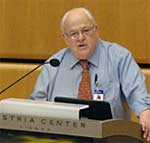 |
Many forecasts of energy demand in the 21st century have been made and all give roughly the same answer. The International Institute of Applied Systems Analysis, for example, shows in its mid-growth scenario (figure 1) primary energy demand increasing by a factor of two by mid-century and by nearly another factor of two by the end of this century. By the year 2030 the developing countries are projected to pass the industrialized ones in primary energy use, and China will pass the United States as the largest energy consumer. It is worth noting that economic growth in China and India is already higher than assumed in the mid-growth scenario.
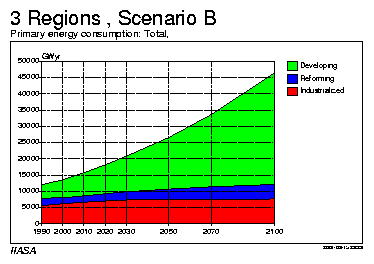
Today, about 80% of primary energy is derived from fossil fuels. Supply constraints on two out of the three fossil fuels are already evident. Oil prices have surged and now are about $60 per barrel. Demand is rising at an average rate of about 1.5 million barrels per day per year, requiring the output of another Saudi Arabia every eight years to keep up with increased demand.
While there is a lot of natural gas, there are transport constraints. Natural gas prices also have risen and now are at the unprecedented level of $9-$10 per million BTU.
The only fossil fuel in abundant supply is coal. However, it has serious pollution problems and expensive technological fixes are required to control environmental problems that have large-scale economic consequences.
Concern about global warming is increasing and even the United States government has finally said that there is a problem. The Intergovernmental Panel on Climate Change (IPCC) forecasts, in the business-as-usual case, an increase in atmospheric carbon dioxide to 750 parts per million by the end of the century with a consequent global temperature rise of 2? to 5? C, less at the equator and more at the poles. We can surely adapt to this increase if it is small and occurs smoothly. If, however, it is large, and accompanied by instabilities in climate, economic and societal disruptions will be very severe.
It is too late to prevent some global warming, but limiting the effect requires a move away from carbon-based fuels. The global-warming issue has caused some prominent environmentalists to rethink their opposition to nuclear power. The question to be confronted is which devil would they rather live with, global warming or nuclear energy? James Lovelock, among others, has come down on the side of nuclear energy.
There are many who believe that solar or wind energy would be a better choice than nuclear. However, these are not now ready for deployment on a large scale. They are costly, but the real problem is that the sun does not shine nor does the wind blow all the time. Until the energy storage problem is solved, solar or wind energy will not make a major contribution to base-load energy.
When economic interests and environmental interests point in the same direction; things can begin to move in that direction, in this case toward the deployment of large-scale carbon-free energy. Nuclear energy is one such source. While it cannot be the entire solution to the energy supply or climate change problems, it can be an important part if the public can be assured that it is safe, that nuclear waste can be disposed of safely, and that the risk of weapons proliferation is not significantly increased by a major expansion.
At present there are about 440 reactors worldwide supplying 16% of world electricity (NEA Annual Report 2004). About 350 of these are in the OECD nations supplying 24% of their electricity. The country with the largest share of nuclear electricity is France at 78%. To an environmentalist, France should be looked at as a model for the world. Its carbon-dioxide intensity (CO2 per unit GDP) is the lowest in the world (figure 2). If the entire world CO2 intensity were as low as France’s, CO2 emissions would be reduced by a factor of two and global warming would be a much easier problem to solve.
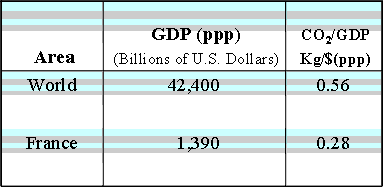
Projections for growth in nuclear power are uncertain because of uncertain costs along with the three potential problems mentioned earlier, safety, waste disposal, and proliferation risk. The International Atomic Energy Agency (IAEA) projection (figure 3) of July 2004 for the year 2030 ranges from a high of 592 GWe to a low of 423 GWe. This represents a net growth of between 16% and 60% over the next 25 years. A recent MIT study (The Future of Nuclear Power – an Interdisciplinary Study, July 2003) projected as much as 1000 GWe by 2050 (an extrapolation of the IAEA high projection for another 20 years), and an Electricite de France projection is for about 1300 GWe (private communication). The more aggressive growth numbers imply completions of about two 1-GWe power plants per month for the next 45 years.
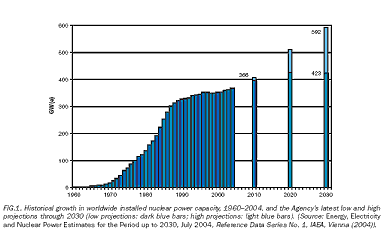
The cost of the new reactor being built in Finland is about Euro 1800 per KWe. Costs will come down with series production and locations more benign than northern Finland. Reactor manufacturers claim that the cost of electricity from a new nuclear plant would be comparable to that from a coal plant after first of a kind engineering cost has been recovered and after coming down the learning curve with five or so new plants. Even so, projections like those above will represent the expenditure of 1-2 trillion dollars on nuclear plants in the next 50 years. It is not clear that we will have the trained personnel for the construction, operation, or regulatory needs of a system that large, so education and infrastructure are issues that need addressing too.
There’s little new to say on safety. Power reactors of the Chernobyl type have never been used outside the old Soviet bloc because of the potential for catastrophic accidents. Even for reactors of that type, the accident would not have happened had not the operators, for reasons we will never know, systematically disabled all of the reactor’s safety systems.
The new generation of light-water reactors has been designed to be simpler to operate and maintain than the old generation, and with more passive safety systems.
With a strong regulation and inspection system, the safety of nuclear systems can be assured. Without one, the risks grow. No industry can be trusted to regulate itself when the consequences of a failure extend beyond the bounds of damage to that industry alone.
In discussing the safe disposition of spent fuel, I will set aside weapons proliferation concerns for now, and return to them later. Looking separately at the three main elements of spent fuel (figure 4), there is little problem with most of it. The uranium which makes up the bulk of the spent fuel is not radioactive enough to be of concern. It contains more U-235 than does natural ore and so could be input for enrichment, or could even be put back in the mines from which it came.
There is no scientific or engineering difficulty with fission fragments, the next most abundant component. The vast majority of them have to be stored for only a few hundred years. Robust containment that would last the requisite time is simple to build.
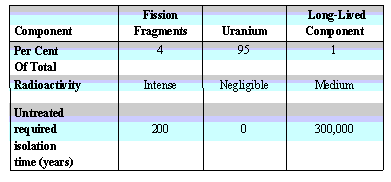
The problem comes mainly from the last 1% of the spent fuel which is composed of plutonium and the minor actinides, neptunium, americium and curium (collectively, the actinides). For some of the components of this mix, the toxicities are high and the lifetimes are long. There are two general ways to protect the public from this material: isolation from the biosphere for hundreds of thousands of years, or destruction by neutron bombardment.
Long term isolation is the principle behind the “once through” system as advocated up to now by the United States for weapons-proliferation-prevention reasons. In a world with a greatly expanded nuclear power program I do not believe the once-through system is workable. There are technical limitations that would require a very large number of repositories, and there is public doubt that the required extremely long isolation times can be achieved.
The first technical problem comes from the heat generated in the first 1500 or so years of storage which limits the density of material that can be placed in a repository. Limitations on the allowed temperature rise of the rock of a repository from this source determine its capacity. The early heat generated from fission fragments is not difficult to deal with. The decay of plutonium-241 to americium-241 which then decays to neptunium-237 is the main source of heat during the first 1000 or so years.
The second technical problem is the very long-term radiation. Here the same plutonium to americium to neptunium decay chain generates the long-lived component that requires isolation from the biosphere for hundreds of thousands of years.
For example, if nuclear energy in the United States were to remain at the present 20% fraction of electricity supply through the end of this century, the spent fuel in a once through scenario would need nine repositories of the capacity of the one proposed at Yucca Mountain. If the number of reactors in the U.S. increases by mid-century to the 300 GWe projected in the MIT study, a new Yucca Mountain would have to open every six or seven years. This would be quite a challenge since we have not been able to open the first one. In the world of expanded use of nuclear power, the once-through cycle does not seem workable.
The alternative to once-through is a reprocessing system that separates the
major components, treating each appropriately and doing something specific to
treat the component that produces the long-term problem. The most developed
reprocessing system is that of France and I will use it as a model. The French
make mixed oxide fuel, MOX, by separating out plutonium from spent fuel and
mixing it with an appropriate amount of uranium from the same spent fuel. (The
extra uranium from the spent fuel not used for MOX goes to an enrichment facility.)
The fission fragments and minor actinides are embedded in glass (vitrification)
for eventual emplacement in a repository. The glass used appears to have a lifetime
of many hundreds of thousands of years in the clay of the proposed French repository.
The French Parliament has held a series of hearings early this year and is expected
to soon issue its report on the acceptability of this system.
MOX fuel plus vitrification solves part of the problem but not all of it. The next question is what to do with the spent MOX fuel. The plan is to keep it unreprocessed until fast-spectrum reactors are deployed commercially. These fast-spectrum reactors burn a mix of plutonium and uranium-238 and can, in principle, burn all of the minor actinides as well which is not possible in the present generation of reactors. It is possible to create a kind of continuous recycling program where the plutonium from the spent MOX fuel is used to start the fast-spectrum system, the spent fuel from the fast-spectrum system is reprocessed; all the plutonium and minor actinides go back into new fuel, and so forth. In principle, nothing but fission fragments goes to a repository and these only need to be stored for a few hundred years. The U.S. has just announced an aggressive R&D program called Global Nuclear Energy Partnership (GNEP) aimed at destroying the actinides in fast-spectrum burners (http://gnep.gov).
This sounds good in principle, but there’s much work to do before putting it into standard, commercial practice. Clearly a coherent international R&D program is the best way to move ahead rapidly.
What we have now are two visions for the long-term solution to the waste problem that are really not that difference (figure 5). In the cycle of figure 5(a), MOX is burned in LWRs and the residue is held for later treatment in a FR. In the cycle of figure 5(b), all of the actinides in LWR spend fuel are separated and treated in the FR.


In the long term, the two visions will merge and become one. The current MOX fuel cycle can stabilize the world’s Pu inventory until the fast systems come along to reduce it, and to burn the minor actinides. The model of figure 5(a) will evolve into that of figure 5(b) where the only materials that get to a repository are fission fragments and the long-lived components that leak into the fission fragment waste stream from inefficiencies in the separation process. If that leakage can be kept to below one percent, the required isolation time is of the order of 1000 years. This is less than the lifetime of the Egyptian pyramids and we should be able to build at least as well.
Preventing the proliferation of nuclear weapons is an important goal of the international community. Achieving this goal becomes more complex in a world with a much expanded nuclear-energy program involving more countries. Opportunities for diversion of weapons-usable material exists at both the front end of the nuclear fuel cycle, the U-235 enrichment stage, and the back end of the nuclear fuel cycle, the reprocessing and treatment of spent fuel stage. The more places this work is done, the harder it is to monitor.
Clandestine weapons development programs have come from both ends of the fuel cycle. Clandestine enrichment programs can lead to U235 weapons. Chemical separation techniques can produce from spent fuel the material needed for plutonium weapons. For example, concern about Iran’s program relate to the enrichment phase, while concern about North Korea’s relate to reprocessing spent fuel.
The level of technical sophistication of the countries that have developed nuclear weapons outside of the NPT range from very low to very high, yet all managed to succeed. The science behind nuclear weapons is well known and the technology seems to be not that hard to master through internal development or illicit acquisition. It should be clear to all that the only way to limit proliferation by nation states it through binding international agreements that include effective inspection as a deterrent, and effective sanctions when the deterrent fails.
We in the science and technology (S&T) community can give the diplomats improved tools that may make the monitoring that goes with agreements simpler and less overtly intrusive. These technical safeguards are the heart of the systems used to identify proliferation efforts at the earliest possible stage. They must search out theft and diversion of weapons-usable material as well as identifying clandestine facilities that could be used to make weapons-usable materials.
The development of advanced technical safeguards has not received much funding recently. An internationally coordinated program for their development needs to be implemented, and proliferation resistance and monitoring technology should be an essential part of the design of all new reactors, enrichment plants, reprocessing facility, and fuel fabrication sites.
Some have asserted that reprocessing of spent fuel leads to less proliferation resistance that the “once through” fuel cycle. Recent analysis, however, seems to show that the “once through” fuel cycle is not significantly more proliferation resistant than reprocessing systems like that used in France (see, for example, “An Evaluation of Proliferation Resistant Characteristics of Light Water Reactor Fuels,” November 2004, available on the DOE’s website (www.nuclear.gov) under “Advisory Committee Reports”). This is an important conclusion since one of the objections to the reprocessing schemes needed to mitigate the spent fuel problem was that it might increase proliferation risk.
Recently the IAEA Director General, Dr. ElBaradei, and United States President, George Bush, have proposed that internationalization of the nuclear fuel cycle be seriously studied. In an internationalization scenario there are countries where enrichment and reprocessing occur. These are the supplier countries. The rest are user countries. Supplier countries make the nuclear fuel and take back spent fuel for reprocessing, separating the components into those that are to be disposed of and those that go back into new fuel.
If such a scheme were to be satisfactorily implemented there would be enormous benefits to the user countries, particularly the smaller ones. They would not have to build enrichment facilities nor would they have to treat or dispose of spent fuel. Neither is economic on small scales and repository sites with the proper geology may not be available in small countries. In return for these benefits, user countries would give up potential access to weapons-usable material from both the front end and the back ends of the fuel cycle.
If this is to work, an international regime has to be created that will give the user nations guaranteed access to the fuel that they require. This is not going to be easy and needs a geographically and politically diverse set of supplier countries to give confidence to user countries that they will not be cut off from the fuel required for an essential part of their energy supply.
Reducing the proliferation risk from the back end of the fuel cycle will be even more complex. It is essential to do so because we have seen from the example of North Korea how quickly a country can “break out” from an international agreement and develop weapons if the material is available. North Korea withdrew from the Non-Proliferation Treaty at short notice, expelled the IAEA inspectors, and reprocessed the spent fuel from their Yongbyon reactor, thus acquiring in a very short time the plutonium needed for bomb fabrication.
However, the supplier countries that should take back the spent fuel for treatment are not likely to do so without a solution to the waste-disposal problem. In a world with a greatly expanded nuclear power program there will be a huge amount of spent fuel generated worldwide. The projections mentioned earlier predict, by mid-century, the deployment of more than a terawatt (electric) of nuclear capacity producing more than 20,000 tons of spent fuel per year. This spent fuel contains about 200 tons of plutonium and minor actinides and 800 tons of fission fragments. The once-through fuel cycle cannot handle it without requiring a new Yucca Mountain scale repository opening somewhere in the world every two or three years.
The U.S. government has recognized this and is changing its R&D direction to focus on reprocessing spent fuel and burning the actinides in fast reactors with continuous recycle. This program, the Global Nuclear Energy Initiative (GNEI) aims to develop the technology to allow the implementation of an internationalized fuel cycle as well as to handle its own nuclear waste. The U.S. long-range program is now aligned with those of France, Russia, China, Japan, Korea, and India. The possibility exists for an effective, international control regime.
In this model the supplier-user scenario might develop as follows. First, every one uses LWRs. Then the supplier countries begin to install fast-spectrum systems. These would be used to supply their electricity needs as well as to burn down the actinides. Eventually, when uranium supplies begin to run short, the user countries would go over to fast-burner systems, while the supplier countries would have a combination of breeders and burners as required.
In summary, nuclear energy is an important component of a strategy to give the world the energy resources it needs for economic development while reducing consumption of fossil fuels with their greenhouse-gas emissions. If this is to happen on a large scale, advances in both physical S&T and political S&T will be required.
We on the physical S&T side can produce better and safer reactors, better ways to dispose of spent fuel, and better safeguards technology. This can best be done in an international context to spread the cost and to create an international technical consensus on what should be done. Countries will be more comfortable with what comes out of such developments if they are part of them.
While the physical S&T development can best be done in an international context, the political S&T can only be done internationally. The IAEA seems to be the best place to start and the first baby steps have already been taken. I look forward to larger steps of both kinds in the future. However, it will be difficult for an organization as large as the IAEA to create a framework for a new international nuclear enterprise if too many voices are involved at the start. Discussions might start off better if a broadly based, but compact, subgroup does the initial work. If I were setting up such a group, the minimum membership would include Canada, China, France, India, Japan, Russia, South Korea, United States, and representatives of the larger potential user states, Brazil and Indonesia, for example. I do not think it will be difficult to create mechanisms for the front end of the fuel cycle. The back end will be the problem and the most intractable issue is likely to be the final waste disposal system.
![]()
© European Nuclear Society, 2006